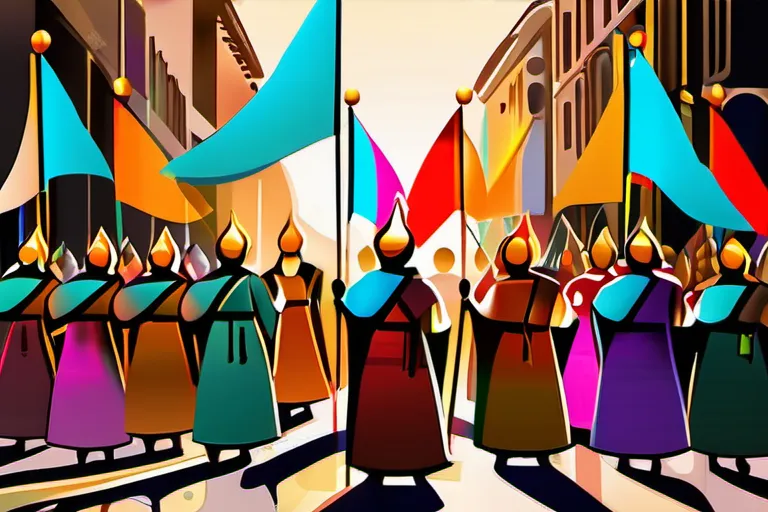Explore the unique beliefs, practices, and traditions of folk Catholicism in this detailed article.
Folk Catholicism is a rich and vibrant expression of the Catholic faith that has evolved over centuries. In this article, we will delve into the key teachings and practices of folk Catholicism, providing you with a comprehensive understanding of this fascinating phenomenon.
The Origins of Folk Catholicism
Imagine a river, its waters flowing through time, carrying the echoes of early Christian communities from centuries ago to the present day. This river, rich in tradition and steeped in history, is none other than Folk Catholicism. How did this unique blend of faith and culture come into existence? Let’s delve into its origins.
From the earliest days of Christianity, the church sought to spread its message across diverse cultures. As it reached remote corners of Europe, Asia, and beyond, local traditions began to intermingle with Christian teachings. Over centuries, these interactions gave birth to folk Catholicism, a vibrant tapestry woven from threads of indigenous beliefs and Christian practices.
Consider the early Christian missionaries who traveled far and wide, not just spreading the Gospel but also adapting their methods to resonate with local customs. In rural communities, saints like Saint Nicholas (the patron saint of children) became deeply intertwined with pre-Christian festivals celebrating winter solstice and other seasonal changes. This adaptation process was a two-way street: while Christianity influenced local traditions, these traditions also shaped Christian practices.
Fast forward to the present day, and you can still see vestiges of this rich history in Folk Catholicism. In many communities, saints are venerated not just for their spiritual attributes but also for their ability to mediate between people and the divine. For instance, Saint Anthony is celebrated not only as a patron against theft and gambling but also for his role in finding lost objects—a nod to earlier folk beliefs about spirits of places.
The journey from early Christian communities to modern Folk Catholicism is a story of adaptation, evolution, and resilience. It’s a story that continues to unfold as new generations reinterpret and rekindle the fires of their faith. As we explore further into this comprehensive guide, remember that every tradition, every belief, and every practice in folk Catholicism tells a unique part of its rich history.
Key Beliefs and Practices
Understanding Key Beliefs and Practices of Folk Catholicism: A Comprehensive Guide
Folk Catholicism, often seen as a vibrant tapestry woven with local traditions and beliefs, invites us to delve into its rich fabric. How do these practices differ from the structured norms we see in mainstream Catholicism? Why are miraculous images and healing rituals so central to this faith experience?
Imagine stepping into a small village where every home holds a special statue or image of a saint, each with its own story. These are not just religious artifacts; they are lifelines connecting the villagers to their spirituality. Why do these images hold such power? Could it be that in their simplicity and local relevance, they offer a closer connection to the divine than abstract doctrines?
Consider the practice of popular devotions. These include processions, pilgrimages, and other rituals unique to specific communities. How do these practices shape the community’s identity? Are they mere superstitions or profound expressions of faith that provide solace and guidance in times of need? Could it be that through these practices, people find a sense of belonging and purpose?
The healing rituals often involve saints who are believed to have special powers. How do these rituals work within the broader context of faith? Do they offer an alternative path to health and well-being or complement traditional medical treatments? Is there any scientific basis for their efficacy, or is it all a matter of belief and placebo effect?
Folk Catholicism thrives on these unique beliefs and practices. It’s not just about following commandments but also about experiencing the divine in everyday life. These traditions remind us that faith isn’t confined to church walls; it can be lived through actions, emotions, and communal rituals.
Regional Variations in Folk Catholicism
How does Catholicism transform when it encounters diverse cultures and landscapes? Folk Catholicism offers a fascinating glimpse into this question, revealing how religious practices evolve to reflect local customs, folklore, and historical influences. From the veneration of local saints in rural Italy to the vibrant processions seen during Easter in Mexico, each region brings its unique flavor to the faith.
Imagine wandering through the rolling hills of southern Italy, where the Benedictine tradition intertwines with local legends. Here, the faithful may pray before a holy icon believed to have miraculous powers, or attend an ancient shrine dedicated to Saint Francis of Paola, who is revered as a saint of healers. These practices blend seamlessly with everyday life, creating a tapestry that honors both universal Catholic teachings and local traditions.
In contrast, the Andes Mountains of South America present another fascinating example. Here, indigenous beliefs have merged with Catholicism to create a syncretic faith where saints are seen as protectors against natural elements. For instance, Saint Christopher is venerated not only for his role in Christian history but also as an intercessor for protection during storms or while crossing rivers. These practices reflect the deep connection between people and their environment, a crucial aspect of folk Catholicism.
Each region’s Catholic expression serves as a reminder that faith is not static but dynamic, adapting to new environments while preserving core doctrines. Whether it’s the colorful Day of the Dead celebrations in Mexico or the mystical Novena de San Diego in the Philippines, these traditions offer insights into how communities find meaning and solace in their local expressions of faith.
Folk Catholicism, then, is more than just a collection of practices; it’s a living, breathing reflection of human experience. By exploring regional variations, we uncover the rich diversity that defines this vibrant form of Christianity, highlighting its ability to grow and evolve with each new cultural soil it touches.
The Role of Saints and Patron Saints
Imagine stepping into a small, cozy church in a remote village, where the walls are adorned with images of saints. These saints are not just figures from ancient history but are vibrant presences that offer protection and guidance to the community. In folk Catholicism, saints play an essential role as protectors, intercessors, and symbols of local identity.
How do these saints come to be so beloved in the hearts of the faithful? Think of them as guardian angels, but with a twist—they are tangible representations of divine protection. For example, Saint Barbara is revered for her role in protecting miners from dangerous explosions, and this makes her a patron saint who offers comfort and security to those working in such hazardous jobs.
The idea that saints can intercede on behalf of the faithful is another fascinating aspect of folk Catholicism. When someone is in need or facing adversity, they might pray to a specific saint, much like calling out for help during a storm. This practice is not just about asking for favors; it’s about building a personal relationship with these holy figures who are seen as close companions and protectors.
Furthermore, patron saints serve as symbols of local identity, weaving into the fabric of community life. They become part of the cultural heritage, celebrated during festivals and feasts. For instance, Saint Anthony is widely venerated in many parts of Latin America, where he is invoked for lost items, making him not just a religious figure but a beloved local icon.
Through these saints and patron saints, folk Catholicism bridges the gap between the divine and the human, creating a rich tapestry of faith that is both deeply personal and community-oriented. It’s a reminder that while the Church may have universal teachings, its practices are often shaped by the unique needs and aspirations of each local community.
The Influence of Folk Catholicism on the Catholic Church
How has folk Catholicism shaped the broader Catholic Church? The influence of folk practices, beliefs, and traditions extends far beyond their local communities, touching the very heart of the global Church. For centuries, these deeply rooted customs have seeped into the liturgy, devotional life, and even pastoral strategies of the Catholic Church.
Consider the practices that have become integral to the wider Church’s rituals. Folk Catholicism often includes colorful processions, vibrant music, and rich symbolism—elements that have enriched the visual and auditory aspects of Catholic worship across many countries. Have you ever wondered why so many churches incorporate local saints into their patronage? This practice is a direct reflection of how folk Catholicism has influenced the broader Church to embrace diverse devotional practices.
The devotional life of individuals within the Church has also been profoundly shaped by folk traditions. The emphasis on personal piety, including novenas, processions, and local feasts, has encouraged a more intimate relationship between believers and the divine. These practices foster a sense of community and shared religious experience, reminding us that faith is not just about doctrine but also about lived practice.
Moreover, folk Catholicism has played a crucial role in shaping pastoral strategies. The Church’s approach to evangelization and social ministry often draws from the rich tapestry of local customs. For example, integrating traditional healing practices with modern medical care or adapting religious instruction to include stories and symbols familiar to the community. These approaches make faith more accessible and meaningful for people who might not find Western-style liturgy relatable.
As we explore these influences, it becomes clear that folk Catholicism is not just a subset of the broader Church but an essential part of its vibrant and dynamic nature. Its teachings, practices, and traditions have enriched the fabric of Catholic life in countless ways, making faith more personal and relevant for believers around the world.
Contemporary Challenges and Future Directions
As we delve into the challenges facing folk Catholicism today, it’s like navigating through a dense forest where every path seems to lead in a different direction. How can this traditional form of Catholic practice continue to thrive in an ever-changing world? The answers may lie within the very fabric of these communities—where rituals are intertwined with daily life and faith is not just believed but felt.
The question arises: In a world dominated by digital communication and instant gratification, how does folk Catholicism hold its ground against the lure of modernity? It’s as if these traditions are the last bastions of a slower, more contemplative way of living—a form of spiritual resistance in an age that often values speed over depth. The challenges include the younger generations’ attraction to more contemporary forms of worship and the pressures of assimilation into mainstream society.
However, there is also a growing recognition among scholars and practitioners alike that folk Catholicism can be a powerful force for renewal. Just as old wine needs new skins, perhaps traditional practices could find fresh relevance by embracing modern technologies and cultural exchanges. The key might lie in finding common ground between the old and the new, creating spaces where traditions can flourish alongside innovation.
Will folk Catholicism adapt and evolve to meet these challenges, or will it fade into obscurity? One thing is certain: the future of this rich tradition depends on its ability to remain relevant while preserving its unique identity. It’s a delicate balance between staying true to age-old practices and opening doors to new possibilities.
As we look forward, the potential for growth and renewal in folk Catholicism seems immense. By fostering dialogue and understanding, these communities can not only preserve their heritage but also contribute fresh insights to the broader Church. Will we see a renaissance where folk practices enrich the global Catholic community? The answer lies in our collective efforts to support and celebrate this vibrant tradition.
Conclusion
 By the end of this article, you will have gained valuable insights into the world of folk Catholicism. You will understand its unique beliefs, practices, and traditions, and appreciate its role in shaping the Catholic faith as we know it today.
By the end of this article, you will have gained valuable insights into the world of folk Catholicism. You will understand its unique beliefs, practices, and traditions, and appreciate its role in shaping the Catholic faith as we know it today.











